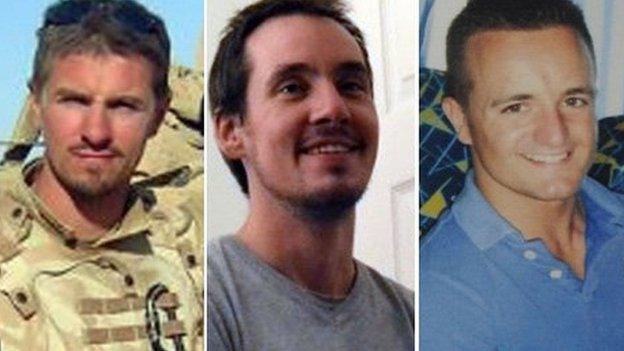SAS selection deaths: Recruit's temperature 'highest' seen
- Published

Cpl James Dunsby, L/Cpl Edward Maher and L/Cpl Craig Roberts took part in the exercise in July 2013
A paramedic with 23 years experience said a heat-stricken Army reservist who collapsed on an SAS test march had the highest temperature he had seen, an inquest has heard.
Cpl James Dunsby's body appeared to be "shutting down" on the Brecon Beacons in July 2013.
The 31-year-old's temperature was 40.4C (104.7F) - well above a normal 37C.
He was one of three reservists to die from overheating on the 16-mile (26km) march on a "boiling hot" day.
Cpl Dunsby, from Trowbridge, Wiltshire, died at Birmingham's Queen Elizabeth Hospital 17 days later.
L/Cpl Craig Roberts, from Penrhyn Bay, Conwy county, died at the scene and L/Cpl Edward Maher died about three hours later at Prince Charles Hospital in Merthyr Tydfil.
The hearing has previously been told the exercise took place on one of the hottest days of the year, with temperatures expected to hit 27C (80.6F).
In a statement on the seventh day of the hearing, Welsh Ambulance clinical team leader Damon James said he did not think L/Cpl Dunsby would survive.
He said he was initially told on arrival there were three people "on the hill" in cardiac arrest.
Mr James added he was approached by an Army officer who told him he was in charge.
Mr James said: "He told me the male (Cpl Dunsby) had been on a four-day exercise and was half-an-hour from the finish.
"He said the male had collapsed about 100 yards up the track. He said they had carried plenty of water but were pushing themselves to the limit."
The hearing in the Solihull, West Midlands, was also told an unnamed walker was earlier asked by an Army officer to fan down Cpl Dunsby, hold his head and watch his breathing while four other soldiers carried him on a stretcher from the hillside.
The inquest continues.
- Published5 June 2015

- Published4 June 2015

- Published3 June 2015
